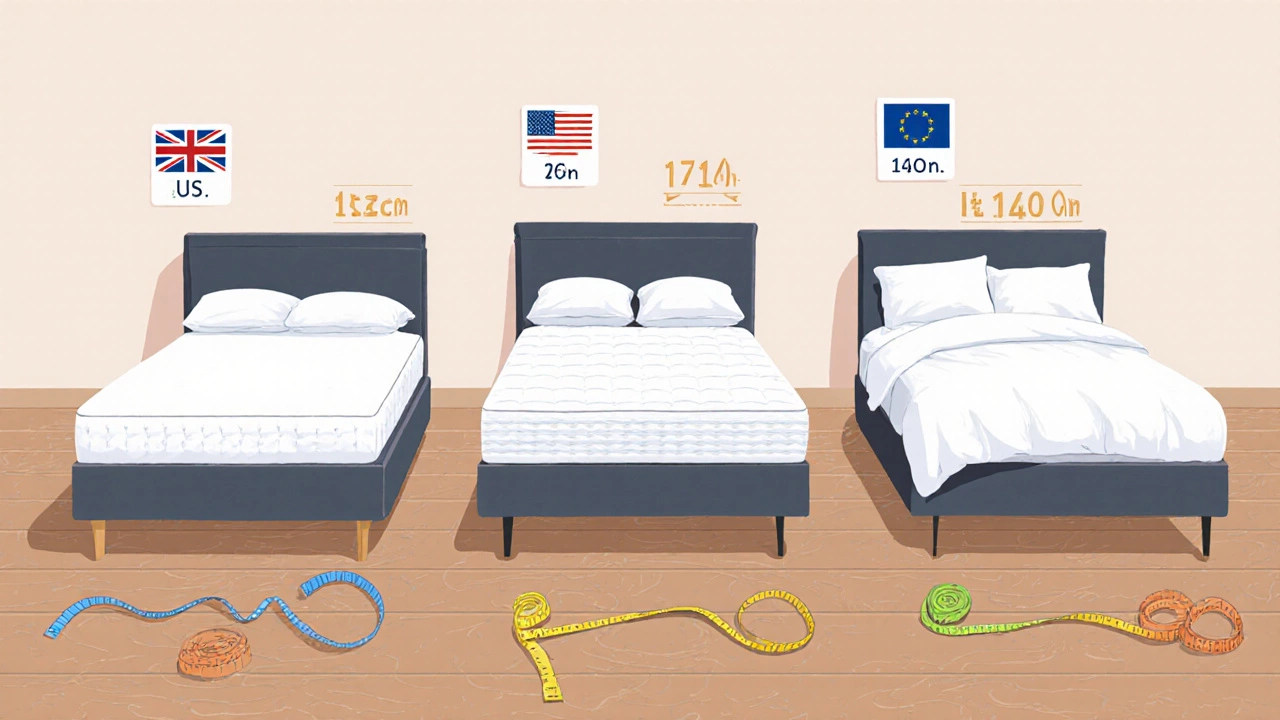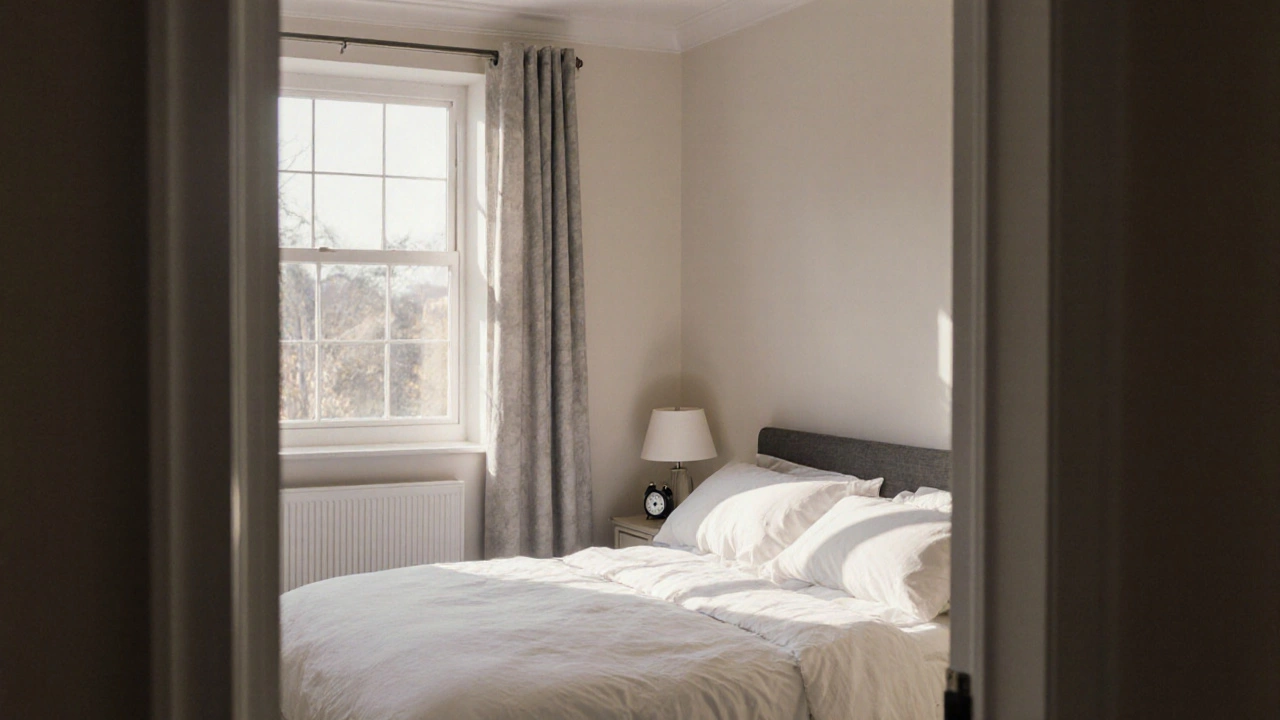Bed Size Calculator
UK Bed Size Calculator
Enter your room dimensions to find the best bed size for your space. Based on UK standard measurements and article recommendations.
When you’re buying new bedding, the first thing you probably check is the price. But if you get the size wrong, no amount of savings will save you from tangled sheets and awkward mattress overhang. So what’s the most popular bedding size in the UK? The answer isn’t as simple as you might think - it depends on who you ask, where you live, and whether you’re sleeping alone or with someone.
Double Bed: The UK’s Default Choice
The most common bedding size across the UK is the double, also known as a 4’6” or 135cm wide bed. It’s the default for couples who don’t need a lot of extra space, first-time buyers, and renters in smaller homes. Nearly 60% of UK households with two adults sleep on a double bed, according to data from the British Bed Manufacturers’ Association. It fits comfortably in most standard bedrooms, even those under 10 square metres.
Why does it dominate? Cost, space, and practicality. A double mattress costs less than a king or super king, and it’s easier to move through narrow staircases and doorways. Most second-hand furniture stores, student accommodations, and Airbnb listings default to double beds. If you’re furnishing a flat or moving into a new place without knowing the room size, the double is the safe bet.
How UK Bed Sizes Compare to Other Countries
Don’t assume a UK double is the same as one in the US or Europe. A UK double is 135cm wide and 190cm long. In the US, a full-size bed (sometimes called a double) is only 137cm wide and 191cm long - almost identical. But in Europe, a standard double is often 140cm wide, and in Australia, it’s 138cm. The differences are small, but enough to cause problems if you order bedding online from abroad.
And don’t get confused by the term ‘double’ in other countries. In the US, a queen is the most common couple’s bed - that’s 152cm wide. In the UK, that’s called a king. So if you’re shopping internationally, always check the measurements in centimetres, not the label.
What About Singles and Kings?
Single beds - 90cm wide and 190cm long - are still the standard for children’s rooms and guest rooms. Around 25% of UK households use a single bed, mostly for teens or occasional visitors. But they’re not growing in popularity. More parents are choosing small doubles (120cm wide) for teenagers, especially in cities where space is tight.
On the other end of the spectrum, king and super king beds are rising slowly. A king is 150cm wide, and a super king is 180cm. These are no longer just for luxury hotels. More couples are upgrading, especially after working from home made bedrooms feel more personal. A 2024 survey by Sleep Council found that 18% of new bed buyers chose a king or super king - up from 9% in 2020. The trend is strongest in the South East and among homeowners with rooms over 14 square metres.

Why Size Matters Beyond Comfort
Getting the wrong size isn’t just about feeling squished. It affects your sleep quality. A mattress that’s too narrow forces you to sleep on the edge, which can cause back pain. A mattress that’s too wide for the frame can sag or shift. And bedding - sheets, duvet covers, pillowcases - won’t fit right if the size is off by even 5cm.
Most people don’t realise that UK bed frames and mattresses aren’t always sold together. You might buy a frame from IKEA and a mattress from a local shop. If you don’t match the exact size, you’ll end up with a 130cm mattress in a 135cm frame - and your fitted sheet will never stay put.
Also, bedding sizes aren’t always labelled clearly. A ‘double duvet’ might be 200cm x 200cm, but a ‘king duvet’ could be 225cm x 220cm or even 260cm x 220cm depending on the brand. Always check the dimensions printed on the label, not the name.
What Size Should You Choose?
Here’s a simple guide based on real-life use:
- Single (90cm): Kids under 13, guest rooms, narrow spaces.
- Small double (120cm): Teens, single adults in small rooms, studio apartments.
- Double (135cm): Most couples, first-time buyers, renters. The safest, most common choice.
- King (150cm): Couples who want space, taller people (over 188cm), or those who move a lot in sleep.
- Super king (180cm): Large bedrooms, luxury homes, people who like to spread out or share the bed with pets.
If you’re unsure, measure your room. You need at least 60cm of space on each side of the bed to walk around comfortably. For a double, that means your room should be at least 2.5m wide. For a super king, aim for 3.2m or more. If your room is smaller, go down a size - even if your partner says they want more space.

What’s Changing in Bedding Sizes?
Bed sizes are slowly shifting. More people are choosing taller mattresses (25cm+), which means the bed frame needs to be deeper. That affects how bedding fits - a standard fitted sheet might not stretch far enough. Brands are starting to offer ‘deep pocket’ sheets as standard, but you still need to check.
Also, eco-conscious buyers are avoiding oversized beds. A super king uses 30% more cotton and takes more energy to produce. Many are opting for a king instead - enough space without the waste. That’s becoming a quiet trend in cities like Bristol, Manchester, and Edinburgh.
And don’t forget the rise of modular beds. Some brands now sell adjustable bases or split mattresses (two 75cm halves) for couples with different comfort needs. These are still niche, but they’re growing fast in the 30-45 age group.
Final Tip: Always Measure Before You Buy
Don’t trust the name on the box. Don’t assume your old bedding fits your new mattress. Use a tape measure. Write down the width and length in centimetres. Then check the label on your sheets and duvet cover. If they don’t match exactly, return them. It’s not worth losing sleep over.
The most popular bedding size in the UK is still the double - but that doesn’t mean it’s right for you. Your size should match your space, your body, and your sleep habits. Not the trend. Not your neighbour’s bed. Just yours.
What is the most common bed size in the UK?
The most common bed size in the UK is the double, measuring 135cm wide by 190cm long. It’s used in nearly 60% of households with two adults and is the default in rentals, student housing, and smaller homes.
Is a double bed big enough for two people?
Yes, a double bed is big enough for two adults, but it’s snug. Each person gets about 67cm of space - roughly the width of a yoga mat. If you or your partner move a lot during sleep, or if you’re both over 180cm tall, a king size (150cm) will feel more comfortable.
What size duvet do I need for a double bed?
For a standard UK double bed (135cm x 190cm), use a duvet that’s 200cm x 200cm. Some brands label this as a ‘double duvet’. Always check the dimensions printed on the tag - sizes can vary by brand, especially if imported.
Why do UK bed sizes differ from US sizes?
The UK and US use different naming systems. A UK double (135cm) is similar to a US full, but a UK king (150cm) is the same as a US queen. A UK super king (180cm) is larger than any standard US size. Always check measurements in centimetres, not labels, when buying bedding online.
Should I buy a larger bed if I have a small room?
No. A bed that’s too large for your room makes the space feel cramped and hard to navigate. You need at least 60cm of walking space on each side. For a double, your room should be at least 2.5m wide. If your room is smaller, choose a small double (120cm) or even a single with a storage bed underneath.

